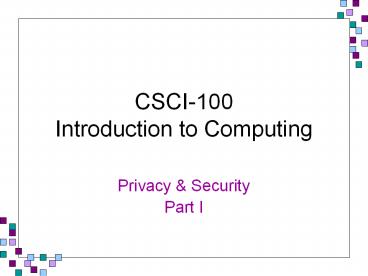CSCI-100 Introduction to Computing - PowerPoint PPT Presentation
Title:
CSCI-100 Introduction to Computing
Description:
CSCI-100 Introduction to Computing Privacy & Security Part I Simplified Communications Model - Diagram Encryption Encryption is the coding and scrambling process by ... – PowerPoint PPT presentation
Number of Views:296
Avg rating:3.0/5.0
Title: CSCI-100 Introduction to Computing
1
CSCI-100Introduction to Computing
- Privacy Security
- Part I
2
- Simplified Communications Model - Diagram
3
- Encryption
- Encryption is the coding and scrambling process
by which a message is made unreadable except by
the intended recipient - Encryption is needed for electronic commerce
- Encryption Basics
- A readable message is called plaintext
- An encryption algorithm is a formula used to make
plaintext unreadable - The coded message is called ciphertext
I LOVE YOU
V YBIR LBH
4
- Symmetric key encryption are encryption
techniques that use the same key to encrypt and
decrypt a message - Strong encryption refers to encryption methods
that are used by banks and military agencies and
are nearly impossible to break
5
- Basic Terminology
- plaintext - the original message
- ciphertext - the coded message
- cipher - algorithm for transforming plaintext to
ciphertext - key - info used in cipher known only to
sender/receiver - encipher (encrypt) - converting plaintext to
ciphertext - decipher (decrypt) - recovering ciphertext from
plaintext - cryptography - study of encryption
principles/methods - cryptanalysis (codebreaking) - the study of
principles/ methods of deciphering ciphertext
without knowing key - cryptology - the field of both cryptography and
cryptanalysis
6
- Symmetric Cipher Model
7
- Two requirements for secure use of symmetric
encryption - a strong encryption algorithm
- a secret key known only to sender / receiver
- Y EK(X)
- X DK(Y)
- Assume encryption algorithm is known
- Implies a secure channel to distribute key
8
(No Transcript)
9
- Classical Substitution Ciphers
- Where letters of plaintext are replaced by other
letters or by numbers or symbols - Caesar Cipher
- Earliest known substitution cipher
- By Julius Caesar
- First attested use in military affairs
- Replaces each letter by k-th letter on
- Example ( what is k ? )
- meet me after the toga party
- PHHW PH DIWHU WKH WRJD SDUWB
10
- Can define transformation (with k 3) as
- a b c d e f g h i j k l m n o p q r s t u v w x y
z - D E F G H I J K L M N O P Q R S T U V W X Y Z A B
C - Mathematically give each letter a number
- a b c d e f g h i j k l m
- 0 1 2 3 4 5 6 7 8 9 10 11 12
- n o p q r s t u v w x y Z
- 13 14 15 16 17 18 19 20 21 22 23 24 25
- Then have Caesar cipher as
- Y EK(X) (X k) mod 26
- X DK(Y) (Y k) mod 26
- EXAMPLE Encrypt howdy using key k 5
11
- Cryptanalysis of Caesar Cipher
- Only have 26 possible ciphers
- A maps to A,B,..Z
- Could simply try each in turn
- A brute force search
- Given ciphertext, just try all shifts of letters
12
(No Transcript)
13
- Brute Force Search
- Always possible to simply try every key
- Most basic attack, proportional to key size































